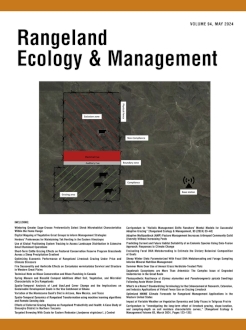Eastern redcedar (ERC) (Juniperus virginiana L.) encroachment into grassland ecosystems, facilitated by shelterbelt planting and fire suppression threatens the long-term health of the Great Plains grasslands. Goats browse (defoliate and debark) juniper tree trunks and branches. Since ERC do not resprout, trunk girdling may kill the tree, making targeted browsing with goats a potential ERC control tool. However, little field experimentation exists. The objective was to investigate how goats browse ERC of different heights and the impact on tree mortality. A randomized complete block design was used with five sites comprised of four replicate paddocks browsed two consecutive summers. Up to ten ERC in five height classes (< 50, 51–100, 101–150, 151–200, and 201–250 cm) were tagged permanently in each paddock and browsing measurements and forage disappearance were recorded. Juniper height was positively related with debarking (y = 0.12x; R2 = 0.29; where x = plant height in cm) and negatively related with defoliation (y = –0.28x + 72.1; R2 = 0.39; where x = plant height in cm). Two sites consistently showed that taller trees had more foliage browning (P < 0.001). Thus, since taller trees are more likely debarked, debarking may be related to tree death. On these sites, ERC trees 151–200 cm had more (P < 0.05) browned foliage and higher (P = 0.01) mortality. Sites with more deciduous browse had less debarking and mortality. Therefore, ERC debarking and mortality success with targeted browsing with goats will most likely depend on site plant community composition characteristics where juniper trees should be the only woody component. Targeted browsing with goats could be an effective ERC site pretreatment when integrated with prescribed fire or other control methods.
BioOne.org will be down briefly for maintenance on 12 February 2025 between 18:00-21:00 Pacific Time US. We apologize for any inconvenience.
How to translate text using browser tools
17 May 2024
Targeted Browsing With Goats for Eastern Redcedar (Juniperus virginiana L.) Control
Alanna M. Hartsfield,
Alexander J. Smart,
Lan Xu,
Kelly A. Froehlich
ACCESS THE FULL ARTICLE

Rangeland Ecology and Management
Vol. 94 • No. 1
May 2024
Vol. 94 • No. 1
May 2024
biological control
Foliage browning
goat
Juniper mortality
woody plant encroachment




